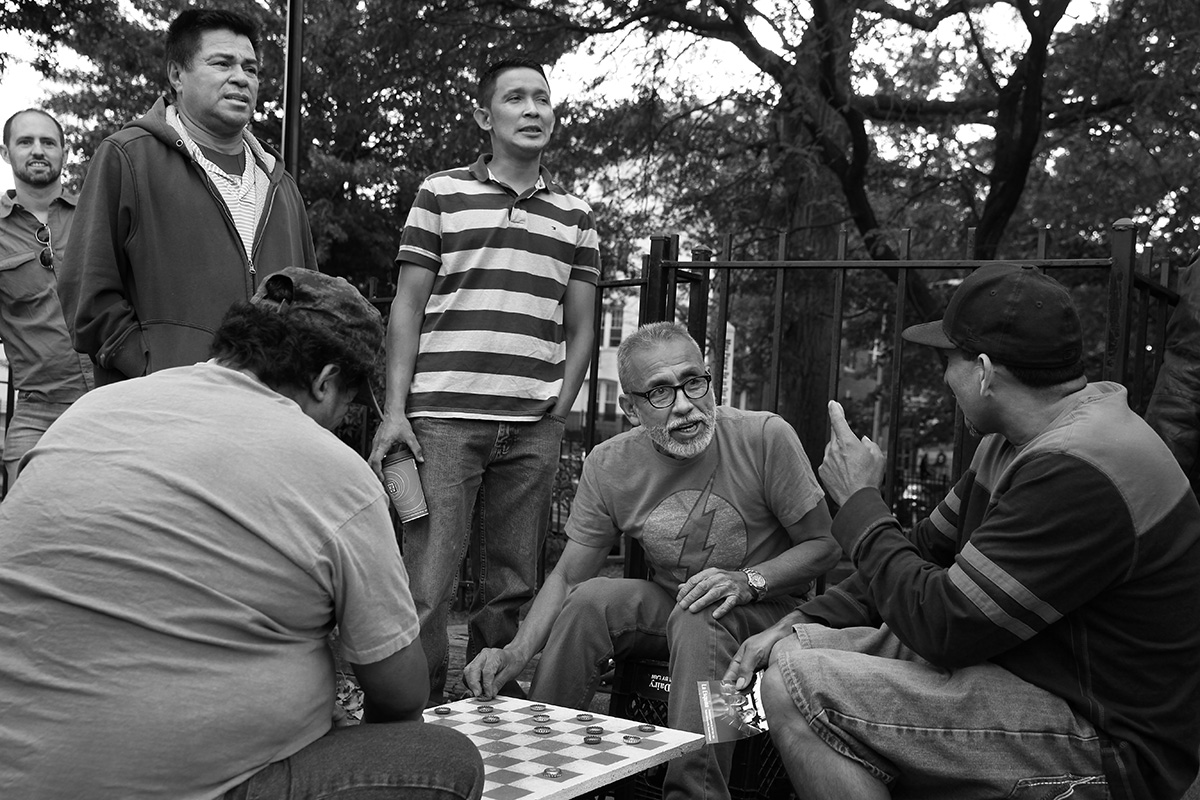“When I came to Washington, D.C., from El Salvador, one of the first things I remember was my mother talking about this place that sounded something like ‘La Manplesa.’ My second Sunday here, my mother was bitching at me and my sister early in the morning—‘Vayan a lavar la ropa!’—to go do the laundry. We put all the dirty clothes in a cart and walked about five blocks to the laundromat. On that Sunday, I found out what ‘La Manplesa’ was. It turned out to be Mount Pleasant Street, La Mount Pleasant. Una calle. A short street. A little street. A nightmare and a dream.”
—Quique Avilés, La Esquina project director
The photo exhibition La Esquina (“The Corner”) pays homage to the Mount Pleasant neighborhood and the group of Latinos who gather regularly on the corner of Mount Pleasant and Kenyon streets next to the 7-Eleven. These esquineros, men, and occasionally a woman or two, have claimed this space for over thirty years.
Most every day they play checkers, banter and joke with each other, talk current events and sports. They share stories of life back home in Latin America, their journey to D.C., and their life in the Latino barrio. In fact, many consider this corner a second home.
Producer: Emma Cregan
Camera: Charlie Weber, Hannah Luc
Story and editing: Kaylie Connors
“The most important milestones of my life have some connection to Mount Pleasant,” project director Quique Avilés concurs. “For most of us, Salvadorans who came in the ’80s and ’90s, landing in D.C. meant landing on Mount Pleasant Street one way or another. If you didn’t live there, you were told about it. There was this notion that ‘if you go there, you will feel better.’ And we needed to feel better. Many of us fleeing Central America were young men avoiding being drafted into the military. This is when Mount Pleasant Street became a haven for lonely men. Here you could find a cure for the heartbreak and loneliness of being away from home because, well, it was home.”
Avilés notes some of the larger implications of life on this street: “Mount Pleasant has been a continuous home away from home for a steady stream of immigrants from Mexico, Central America, the Caribbean, and other countries. Mount Pleasant Street and its surrounding corners is where we, Salvadorans, became Latinos. To this day, Mount Pleasant is a place you go to find companionship—panas, migos, broders, primos, y que ondas.”
Long-time Mount Pleasant photojournalist Rick Reinhard created the images for the exhibition. To complement the photographs, the project team also recorded the stories of the esquineros. Through these stories, we gain an intimate perspective on the history of the D.C. Latino community. Some stories go back to the beginnings of the community in the early 1970s, but most are from the 1980s when there was a great migration of Salvadorans fleeing civil war. These narratives recall the cultural life of Mount Pleasant—everything from festivals and the 1991 riots to the displacement residents suffer as the neighborhood changes and new people arrive.

-
1 / 5The May Day Immigrants Rights March and Rally began in Mount Pleasant and moved to Lafayette Park, across the street from the White House, on May 1, 2017.Photo © Rick Reinhard
-
2 / 5The May Day Immigrants Rights March and Rally began in Mount Pleasant and moved to Lafayette Park, across the street from the White House, on May 1, 2017.Photo © Rick Reinhard
-
3 / 5On November 2, 2013, Mount Pleasant residents celebrated the anniversary of Radio CPR and the Day of the Dead, gathering in Lamont Park to build an altar.Photo © Rick Reinhard
-
4 / 5Oscar Hernandez, esquineroPhoto © Rick Reinhard
-
5 / 5“El Rana” (right) plays checkers at la esquina.Photo © Rick Reinhard
Click on the photo above to view full slideshow
“With the rapid change, there are multiple Mount Pleasants, multiple communities who may see each other along Mount Pleasant Street, but don’t converse, and engage only when necessary,” observes project member Hugo Najera, aka DJ Mezkla. “I walk past certain places in search of others, hopping along islands of community in a sea of change, quite different from walking along Mount Pleasant with my grandmother at eight years old. There is no denying there were dangers, issues, or problems in the neighborhood, but it seemed safer.”
The exhibition aims to start a conversation between esquineros and other residents of Mount Pleasant. The idea is to address neighborhood concerns, cultural differences, and feelings of harassment, racism, and fear. Perhaps this exhibition will also speak to other neighborhoods throughout the country.
“We encourage everyone to use this exhibition as an opportunity to have a conversation where we take inventory of our own position and space, our biases and beliefs, and what that means in working with others in our communities,” Najera says. “La Esquina is a presentation of people, and an invitation (or a challenge to some) to look beyond trends, and begin taking action to bring your love to this community.”
La Esquina was recently featured at the 2018 Latinx Conference in Washington, D.C. In September, the exhibit will be part of La Fiesta del Barrio celebrating La Clínica del Pueblo’s thirty-fifth anniversary. La Clínica is a community health clinic located on Fifteenth Street NW that recently opened a second clinic on Mount Pleasant Street. La Fiesta del Barrio street festival will be celebrated on Mount Pleasant Street on September 16, 11 a.m. to 4 p.m.

Olivia Cadaval is an advisor with the La Esquina exhibition and a research associate at the Smithsonian Center for Folklife and Cultural Heritage.






